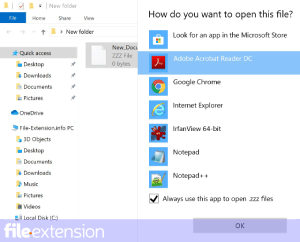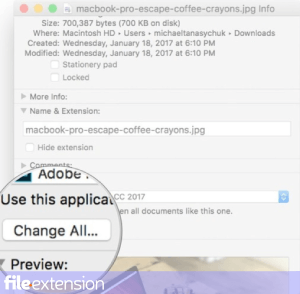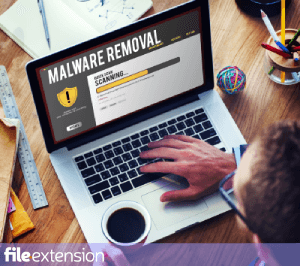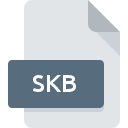
URL File Extension
Internet Shortcut
-
Category
-
Popularity3.3 (26 votes)
What is URL file?
URL is short for Uniform Resource Locator. URL files can points to website, network disk, or share file location on the network. Web addresses in URL files can be accessed using external applications if user’s default web browser is configured to run external programs. If that is the case, the browser automatically closes and transfers controls to the external program. URL file can be created manually by opening a new file and copying the web address into it or by dragging a web link to desktop, in which case an URL will be automatically created.
Security concerns.
URL files along with their local counterparts LNK can be potentially dangerous and therefore should not be sent to other users via email, for example. Windows will not display the extension of an URL file even if the “Hide extensions for known file types” option is disabled. Malicious URL files when opened can direct to servers with potentially dangerous data.
Programs which support URL file extension
Files with URL extension, just like any other file formats, can be found on any operating system. The files in question may be transferred to other devices, be it mobile or stationary, yet not all systems may be capable of properly handling such files.
Programs that support URL file
Updated: 02/08/2023
How to open file with URL extension?
Being unable to open files with URL extension can be have various origins. On the bright side, the most encountered issues pertaining to Internet Shortcut files aren’t complex. In most cases they can be addressed swiftly and effectively without assistance from a specialist. We have prepared a listing of which will help you resolve your problems with URL files.
Step 1. Download and install Microsoft Internet Explorer
 Problems with opening and working with URL files are most probably having to do with no proper software compatible with URL files being present on your machine. The most obvious solution is to download and install Microsoft Internet Explorer or one to the listed programs: Mozilla Firefox, Safari, Windows Notepad. The full list of programs grouped by operating systems can be found above. The safest method of downloading Microsoft Internet Explorer installed is by going to developer’s website (Microsoft Corporation) and downloading the software using provided links.
Problems with opening and working with URL files are most probably having to do with no proper software compatible with URL files being present on your machine. The most obvious solution is to download and install Microsoft Internet Explorer or one to the listed programs: Mozilla Firefox, Safari, Windows Notepad. The full list of programs grouped by operating systems can be found above. The safest method of downloading Microsoft Internet Explorer installed is by going to developer’s website (Microsoft Corporation) and downloading the software using provided links.
Step 2. Verify the you have the latest version of Microsoft Internet Explorer
 If the problems with opening URL files still occur even after installing Microsoft Internet Explorer, it is possible that you have an outdated version of the software. Check the developer’s website whether a newer version of Microsoft Internet Explorer is available. Software developers may implement support for more modern file formats in updated versions of their products. If you have an older version of Microsoft Internet Explorer installed, it may not support URL format. The most recent version of Microsoft Internet Explorer is backward compatible and can handle file formats supported by older versions of the software.
If the problems with opening URL files still occur even after installing Microsoft Internet Explorer, it is possible that you have an outdated version of the software. Check the developer’s website whether a newer version of Microsoft Internet Explorer is available. Software developers may implement support for more modern file formats in updated versions of their products. If you have an older version of Microsoft Internet Explorer installed, it may not support URL format. The most recent version of Microsoft Internet Explorer is backward compatible and can handle file formats supported by older versions of the software.
Step 3. Assign Microsoft Internet Explorer to URL files
If you have the latest version of Microsoft Internet Explorer installed and the problem persists, select it as the default program to be used to manage URL on your device. The process of associating file formats with default application may differ in details depending on platform, but the basic procedure is very similar.

Change the default application in Windows
- Choose the entry from the file menu accessed by right-mouse clicking on the URL file
- Select
- Finally select , point to the folder where Microsoft Internet Explorer is installed, check the Always use this app to open URL files box and conform your selection by clicking button

Change the default application in Mac OS
- Right-click the URL file and select
- Open the section by clicking its name
- Select the appropriate software and save your settings by clicking
- If you followed the previous steps a message should appear: This change will be applied to all files with URL extension. Next, click the button to finalize the process.
Step 4. Check the URL for errors
Should the problem still occur after following steps 1-3, check if the URL file is valid. Problems with opening the file may arise due to various reasons.

1. Verify that the URL in question is not infected with a computer virus
If the file is infected, the malware that resides in the URL file hinders attempts to open it. Immediately scan the file using an antivirus tool or scan the whole system to ensure the whole system is safe. If the scanner detected that the URL file is unsafe, proceed as instructed by the antivirus program to neutralize the threat.
2. Check whether the file is corrupted or damaged
Did you receive the URL file in question from a different person? Ask him/her to send it one more time. The file might have been copied erroneously and the data lost integrity, which precludes from accessing the file. If the URL file has been downloaded from the internet only partially, try to redownload it.
3. Check if the user that you are logged as has administrative privileges.
Sometimes in order to access files user need to have administrative privileges. Log out of your current account and log in to an account with sufficient access privileges. Then open the Internet Shortcut file.
4. Make sure that the system has sufficient resources to run Microsoft Internet Explorer
The operating systems may note enough free resources to run the application that support URL files. Close all running programs and try opening the URL file.
5. Verify that your operating system and drivers are up to date
Latest versions of programs and drivers may help you solve problems with Internet Shortcut files and ensure security of your device and operating system. It is possible that one of the available system or driver updates may solve the problems with URL files affecting older versions of given software.
Conversion of a URL file
File Conversions from URL extension to a different format
File conversions from other format to URL file
Do you want to help?
If you have additional information about the URL file, we will be grateful if you share it with our users. To do this, use the form here and send us your information on URL file.

 Windows
Windows 





 MAC OS
MAC OS 
